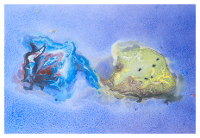Speaker
Dr
Robert Kaminski
(Institute of Nuclear Physics PAN, Krakow, Poland)
Description
Recently reparameterized $f_0(500)$ (former $\sigma$) meson became subject of a number of innovative works in QCD physics.
Difficult to find and to determine experimentally after many years of failures has been finally precisely described be means of theoretical dispersion relations with imposed crossing symmetry condition [1,2].
Its fundamental importance for low energy QCD opened up the possibility of constructive examination of its internal structure but also allowed for study
of delicate phenomena like CP violation via final strong pion-pion state interactions.
History of this meson, of its almost re-discovery two years ago, and its importance for QCD will be discussed.
Also presented will be evidence of the uniqueness of the dispersion method used to obtain its parameters.
Example of a successful application of dispersive method in modification of coupled channel $\pi\pi$, $K\bar K$ and $\eta\eta$ amplitudes fitted in past only to experimental data and not fulfilling crossing symmetry condition will be presented.
Several questions concerning the possibility of extending the dispersion method for study of the low energy QCD will be selected.
[1] "The Pion-pion scattering amplitude. IV: Improved analysis with once subtracted Roy-like equations up to 1100~MeV", R. Garcia-Martin, R. Kaminski, J. R. Pelaez, J. Ruiz de Elvira and F.J. Yndurain, Phys. Rev. D83, 074004 (2011); "Precise determination of the $f_0(600)$ and $f_0(980)$ pole parameters from a dispersive data analysis", R. Garcia-Martin, R. Kaminski, J. R. Pelaez and J. Ruiz de Elvira, Phys. Rev. Lett. 107 (2011) 072001,
[2] "Mass and width of the lowest resonance in QCD",
I. Caprini, G. Colangelo and H. Leutwyler, Phys. Rev. Lett. 96, 132001 (2006)
Summary
The described method, its uniqueness and precision of the results should facilitate modification of often used incorrect $\pi\pi$ amplitudes. This should significantly increase the reliability of obtained results (e.g. in decays of heavy mesons) and accelerate research on other light mesons - candidates for being the lightest non quark-antiquark states.
Author
Dr
Robert Kaminski
(Institute of Nuclear Physics PAN, Krakow, Poland)
